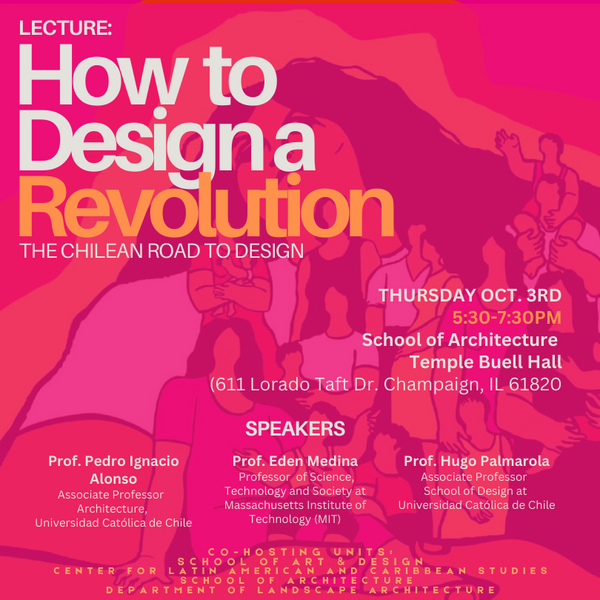
How to Design a Revolution: The Chilean Road to Design
- Event Type
- Lecture
- Sponsor
- School of Art and Design, Center for Latin American and Caribbean Studies, School of Architecture Department of Landscape Architecture
- Location
- School of Architecture Temple Buell Hall (611 Lorado Taft Dr. Champaign, IL 61820
- Date
- Oct 3, 2024 5:30 - 7:30 pm
- Views
- 300
- Originating Calendar
- Center for Latin American and Caribbean Studies (CLACS)
Visiting Artist Series: Eden Medina, Hugo Palmarola & Pedro Ignacio Alonso, “How to Design a Revolution: The Chilean Road to Design”
October 3, 2024
Thursday, 5:30 PM – 7:30 PM
Plym Auditorium, Temple Buel Hall
From September 7th 2023, to February 28th 2024, Hugo Palmarola, Eden Medina, and Pedro Ignacio Alonso curated a major exhibition at the La Moneda Cultural Centre in Santiago de Chile titled How to Design a Revolution: The Chilean Road to Design, that was followed by the publication of an eponymous book (Lars Muller: 2024). This lecture will present both the exhibition and book, including the curators’ integral reconstruction of Cybersyn’s Operations Room. In order to bring Chile’s industries under the state administration of Salvador Allende’s government, a management system called the Cybersyn Project (an acronym for cybernetic synergy) was developed. Under the coordination of the Technological Research Committee of Chile (INTEC) and the Corporation for the Promotion of Production (CORFO), this project was directed by British cybernetician Stafford Beer in collaboration with a team of industrial and graphic designers led by Gui Bonsiepe. For the Cybersyn’s operating room, Beer requested the efficiency of a war room combined with the comfort of a social club in order to enable fast decision making based on information obtained from the newly nationalized factories. Through the system’s almost real-time data-feed a simplified data visualization could be presented on screens viewed from controlling swivel-chairs built in fiberglass. The talk will outline the history of the original project, highlighting the role of interdisciplinary work in a contemporary reconstruction advancing historical research, scholarship, and curatorship.
Artist Biographies:
Hugo Palmarola is an associate professor at the School of Design at PUC Chile. He holds a PhD in Latin American studies from UNAM Mexico and won the 2018 student essay prize from the Design History Society in the United Kingdom for his research. With Pedro Alonso, he received the 2014 Silver Lion for the Chilean Pavilion Monolith Controversies at the Venice Architecture Biennale, and they received the 2014 Deutsches Architekturmuseum Book Award for its companion book (Hatje Cantz, 2014). Palmarola and Alonso also published the book Panel (Architectural Association, 2014); curated the exhibition Flying Panels at ArkDes in Sweden (2019–20) and published a book under the same title (Dom, 2019). Together with Alonso, he has been a researcher on projects about the Pulkovo observatories and NASA satellite stations (2015–21). Palmarola obtained the MIT MISTI fund (2021–23), with Eden Medina and Pedro Alonso. Alongside them, he curated the exhibition How to Design a Revolution: The Chilean Road to Design at the Centro Cultural La Moneda (2023–24); published a book under the same title (Lars Müller Publishers, 2024); and carried out the first comprehensive and functional reconstruction of the operations room of the 1973 cybernetic project Cybersyn (2023).
Eden Medina is full professor of science, technology and society at MIT and a historian of science and technology. She is the author of Cybernetic Revolutionaries: Technology and Politics in Allende’s Chile (MIT Press, 2011), which won the 2012 Edelstein Prize for best book on the history of technology and the 2012 Computer History Museum Prize for best book on the history of computing. Her coedited volume, Beyond Imported Magic: Essays on Science, Technology, and Society in Latin America (MIT Press, 2014), received the Amsterdamska Award from the European Society for the Study of Science and Technology (2016). Her research studies the relationship of science, technology, design and processes of political change. She holds a Ph.D. in the history and social study of science and technology from MIT and a master’s in studies of law from Yale Law School.
Pedro Ignacio Alonso holds a Ph.D. in architecture from the Architectural Association, in London and heads the Ph.D. program in Architecture and Urban Studies at Pontificia Universidad Católica de Chile. Alonso was a Princeton-Mellon Fellow at Princeton University in 2015-2016 and Resident Architect at the Rockefeller Foundation Bellagio Centre in Bellagio in 2019. With Hugo Palmarola, he was awarded the 2014 Silver Lion for the Chilean Pavilion Monolith Controversies at the Venice Architecture Biennale. Alonso and Palmarola published Panel (AA Publications, 2014); curated the exhibition Flying Panels: How Concrete Panels Changed the World at the Swedish Centre for Architecture and Design in 2019–2020 in Stockholm; and published a book under the same title (Dom, 2019). Other publications include Cycles: The Architects Who Never Threw Anything Away (Circo de Ideias, 2022) with Pamela Prado; and How to Design a Revolution: The Chilean Road to Design (Lars Muller: 2024) co-edited with Eden Medina and Hugo Palmarola.